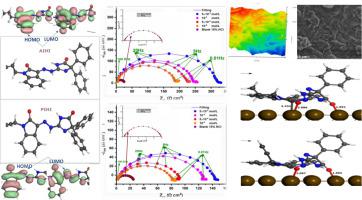Journal of Molecular Structure ( IF 4.0 ) Pub Date : 2024-01-17 , DOI: 10.1016/j.molstruc.2024.137592 Abdelkarim Ait Mansour , Hassane Lgaz , Abderrazzak Elmoutaouakil Ala Allah , Jang JongMin , Mouslim Messali , Lahcen Bazzi , Han-seung Lee , Youssef Ramli , Rachid Salghi

|
Effective corrosion management is a pivotal challenge facing various industries and holds crucial importance in aligning industrial processes with sustainability goals. This study focused on the synthesis and evaluation of two indolin-2-one derivatives: (E)-1-allyl-3-(2-(5-oxo-4,4-diphenyl-4,5-dihydro-1H-imidazol-2-yl)hydrazono)indolin-2-one (AIHI) and (E)-3-(2-(5-oxo-4,4-diphenyl-4,5-dihydro-1H-imidazol-2-yl)hydrazono)-1-(prop-2-yn-1-yl)indolin-2-one (PIHI), as sustainable corrosion inhibitors for N80 carbon steel (N80CS) in a 15 wt. % HCl medium. Chemical, electrochemical, and surface characterization techniques were utilized to evaluate the corrosion inhibition mechanism and the performance of the compounds under investigation. The weight loss method highlighted that tested compounds exhibited promising inhibition efficiencies: 91.54% for AIHI and 81.97% for PIHI, respectively, at 303K, with an outstanding performance of 87.17% at 363K for AIHI. The simultaneous addition of AIHI and PIHI in HCl led to a substantial increase in the polarization resistance (RP) and a remarkable decrease in the corrosion current density (icorr). The potentiodynamic polarization (PDP) technique validated that both indolin-2-one compounds function as anodic/cathodic corrosion inhibitors with remarkable anodic effect. Scanning electron microscopy (SEM) and atomic force microscopy (AFM) showed that inhibitors altered steel surface morphology, forming a protective layer, and significantly reduced surface roughness. Atomistic simulations (DFT and SCC-DFTB methods) pointed out that the inhibitors AIHI and PIHI acted by physico-chemical adsorption through donor-acceptor interactions between AIHI or PIHI molecules (s and p orbitals) and the 3d orbitals of Fe(110). The insights obtained serve as a foundation for future advancements in greener corrosion management strategies for sustainable industrial applications, thus reinforcing our commitment to bio-circular economies and sustainable chemistry.
中文翻译:

Indolin-2-one 衍生物作为腐蚀抑制剂:通过实验和计算技术的结构洞察和评估
有效的腐蚀管理是各个行业面临的关键挑战,对于使工业流程与可持续发展目标保持一致至关重要。本研究重点关注两种二氢吲哚-2-酮衍生物的合成和评价:(E)-1-烯丙基-3-(2-(5-氧代-4,4-二苯基-4,5-二氢-1H-咪唑) -2-基)亚肼基)二氢吲哚-2-酮 (AIHI) 和 (E)-3-(2-(5-氧代-4,4-二苯基-4,5-二氢-1H-咪唑-2-基) Hydrazono)-1-(prop-2-yn-1-yl)indolin-2-one (PIHI),作为 15 重量份 N80 碳钢 (N80CS) 的可持续腐蚀抑制剂。% HCl 介质。利用化学、电化学和表面表征技术来评估所研究的化合物的腐蚀抑制机制和性能。减重方法强调,测试化合物表现出令人鼓舞的抑制效率:在 303K 时,AIHI 和 PIHI 分别为 91.54% 和 81.97%,其中 AIHI 在 363K 时表现出色,为 87.17%。在 HCl 中同时添加 AIHI 和 PIHI 导致极化电阻 (R P ) 大幅增加,腐蚀电流密度 (i corr )显着降低。动电位极化(PDP)技术验证了两种吲哚啉-2-酮化合物均可作为阳极/阴极缓蚀剂,具有显着的阳极效应。扫描电子显微镜(SEM)和原子力显微镜(AFM)显示抑制剂改变了钢的表面形态,形成保护层,并显着降低表面粗糙度。原子模拟(DFT和SCC-DFTB方法)指出抑制剂AIHI和PIHI通过AIHI或PIHI分子(s和p轨道)与Fe(110)3d轨道之间的供体-受体相互作用通过物理化学吸附发挥作用。获得的见解可以为可持续工业应用的绿色腐蚀管理策略的未来发展奠定基础,从而加强我们对生物循环经济和可持续化学的承诺。







































 京公网安备 11010802027423号
京公网安备 11010802027423号